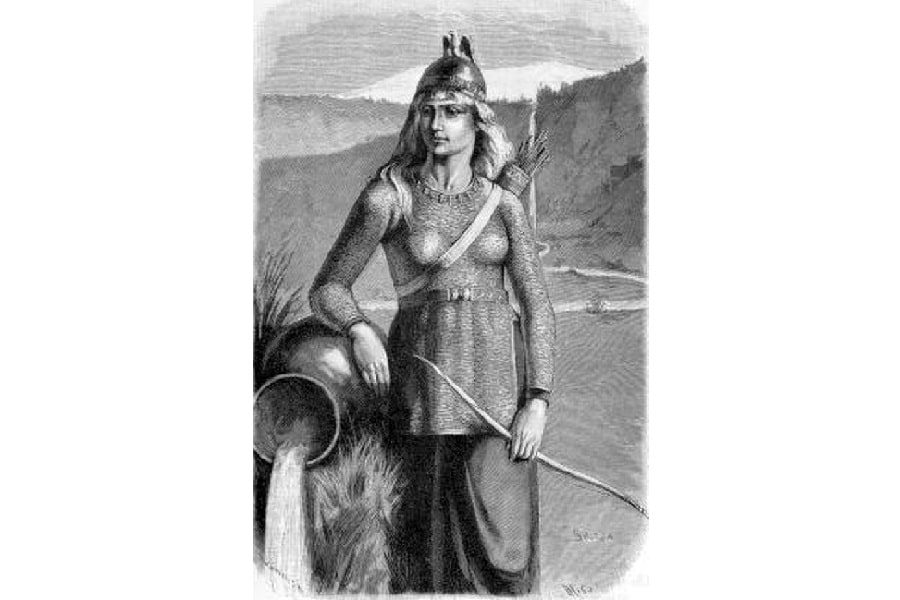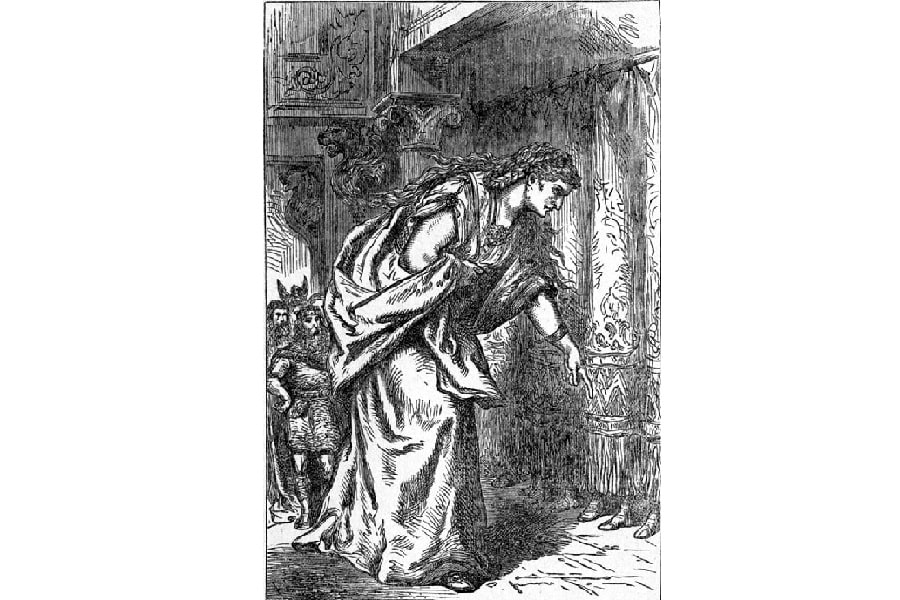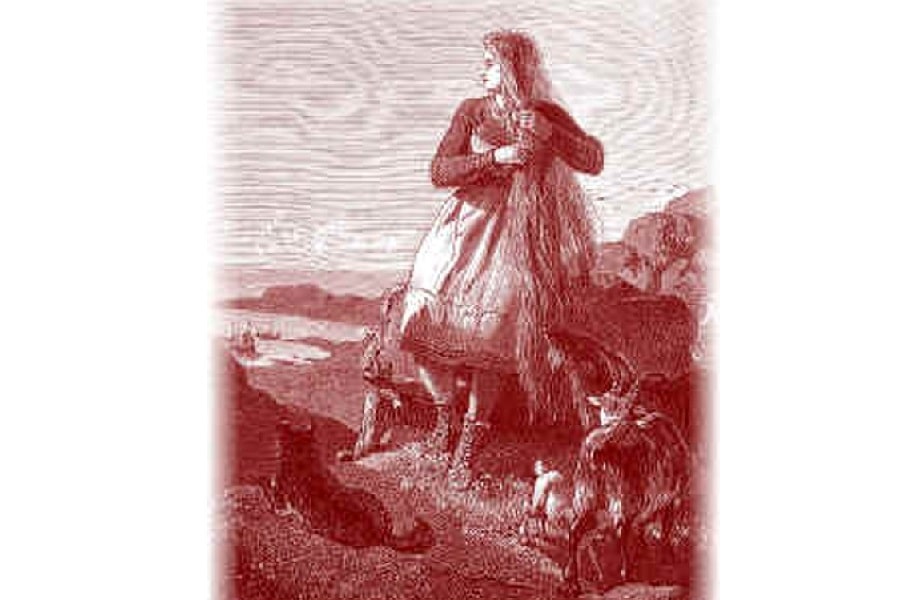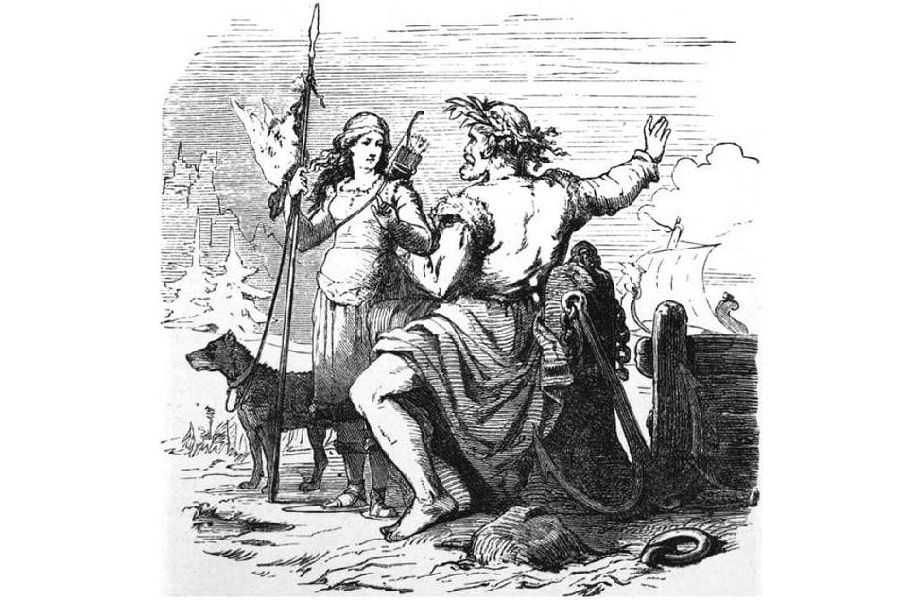Skadi, the giantess goddess of Norse mythology, is a captivating figure that stands out for her multifaceted nature. Her story reflects the complex beliefs and practices of the Norse people, and her role in Norse mythology is both significant and enduring. As a goddess, she is revered for her association with winter, hunting, and skiing, which represents the harsh and unforgiving nature of the northern wilderness.
As a giant [6], she embodies the power and strength of the primordial forces of nature. Skadi’s story offers a unique insight into the mythology of the Norse people and provides a glimpse into their culture and history. Her story has captured the imagination of artists, writers, and storytellers for centuries, and her influence extends beyond the boundaries of Norse mythology [4].
Table of Contents
Who is Skadi?
Skadi is a complex character in Norse mythology. As a giantess, Skadi is associated with winter, hunting, and skiing [8], all of which reflect her origins as a creature of the harsh and unforgiving wilderness. Her association with winter is particularly significant, as it symbolizes the long, dark months of the Scandinavian winter and the challenges it poses to those who live in the region.
As a goddess of the hunt, Skadi is revered for her ability to track and kill even the most elusive prey. In many depictions of Skadi, she is shown holding her bow and arrows, ready to take down her quarry. Her prowess as a hunter is a testament to her strength and skill, as well as her fierce independence and self-sufficiency.
Family and Background

Skadi’s family background is key to understanding her character and her place in Norse mythology. According to mythological sources, Skadi was the daughter of Thiazi, a giant who had a particular grudge against the gods of Asgard. Thiazi was killed by the god Loki, who tricked him into transforming into an eagle and then killed him. Seeking revenge for her father’s death, Skadi went to Asgard to confront the Norse gods. The gods, seeking to appease her and avoid further conflict, offered her a marriage proposal [2].
Skadi agreed to the marriage, but on one condition: that the gods would make her laugh. The gods attempted to entertain Skadi, but their jokes and antics fell flat. Finally, Loki tied a rope to a goat and then to his own genitals, causing both the goat and Loki to scream in pain. Skadi was amused and laughed, thus sealing the deal.
However, Skadi soon found that life in Asgard did not suit her. She was accustomed to the cold and isolation of the mountains, and the noise and merriment of the gods grated on her nerves.
Consequently, she asked the gods to allow her to return to her homeland, but they refused. Instead, they offered to grant her any boon she desired, with the condition that she could only choose a husband by looking at their feet [1].
Skadi chose Njord, the god of the sea, believing that his feet would be beautiful and refined like the rest of him. However, when she saw his legs and realized they were too skinny and pale, she was disappointed. Skadi and Njord attempted to make their marriage work, but eventually, they parted ways amicably.
As the daughter of a giant, Skadi is both an outsider and an ally of the gods. Her marriage to Njord highlights the tension between her nature as a mountain-dwelling goddess and her attempt to integrate into the more refined and cultured world of the gods. Skadi’s story also highlights the importance of humor and play in Norse mythology, as well as the ways in which the gods sought to avoid conflict by negotiating with their enemies [2].

Skadi’s Appearance and Personality
Skadi’s physical appearance is significant in Norse mythology, as it contributes to her unique character and the role she plays in the stories. She is often depicted as taller than the average pagan god or goddess, which emphasizes her status as a giantess. Her piercing blue eyes and long hair give her an air of authority and fierceness, while the furs she wears suggest her connection to the wilderness and the animals she hunts.
Skadi’s bow and arrows are symbols of her hunting prowess and her skill as a warrior, which are traits that are traditionally associated with men in many cultures. However, in Norse mythology, Skadi’s use of these weapons highlights her independence and strength as a woman.
Skadi’s personality is just as distinctive as her appearance. She is a strong and determined figure who is unafraid to challenge the gods and assert her independence. Skadi’s fierce and independent spirit makes her a powerful symbol of female agency and empowerment, particularly in a male-dominated mythology. Despite her status as a goddess, Skadi is often portrayed as an outsider in Norse mythology, which reflects her origins as a giantess. She is not afraid to stand up for what she believes in, even if it means going against the gods.
Skadi’s Skis
Skadi’s most unique attribute, however, is her skis. She is the only character in Norse mythology who is associated with skiing, which speaks to her status as a giantess and her close connection to the natural world. Skadi’s skiing ability is often celebrated in art and literature, as it represents her ability to move through the harsh winter landscape with ease and grace. Her skis also symbolize her independence and self-sufficiency, as they allow her to navigate the wilderness on her own terms [3].

Skadi and the Death of Baldr
Skadi’s involvement in the death and resurrection of Baldr is one of her most significant roles in Norse mythology. Baldr was a beloved god, and his death at the hands of Loki had far-reaching consequences for the entire Norse pantheon [5].
In Norse mythology, Baldr was killed by his blind brother, Höðr, who was manipulated by the mischievous god Loki. The gods then sought to bring Baldr back to life, and Skadi was among the many figures who played a part in this effort.
According to the Prose Edda, the gods enlisted the help of the giantess Hyrrokkin to launch Baldr’s funeral ship out to sea. When the ship was stuck and unable to move, the gods called upon Skadi to help free it. Skadi used her knowledge of skiing and her powerful magic to push the ship out to sea and send it on its way [1].
Skadi was one of the many gods and goddesses who were affected by Baldr’s death, and her relationship with the other gods was forever changed as a result. This event highlights Skadi’s position as a powerful figure in Norse mythology, one whose actions could have far-reaching consequences for the other gods and for the world itself.
Skadi’s involvement in Baldr’s resurrection is somewhat indirect, but it does demonstrate her willingness to aid the gods in times of need. Her strength, magical abilities, and close connection to nature all made her a valuable ally to the gods, particularly in the face of challenges and obstacles. Skadi’s role in the story of Baldr’s death and resurrection serves as a reminder of her importance and influence in Norse mythology, even in moments when she may not be at the forefront of the action.

Skadi and the Myth of the Binding of Loki
Skadi’s story is also intertwined with the myth of the binding of Loki. In this story, Skadi plays a pivotal role in punishing Loki for his crimes against the gods. After Loki’s treachery is revealed, Skadi is one of the gods who participates in his punishment, which involves binding him to a rock and having a serpent drip venom onto his face [1]. This punishment reflects Skadi’s role as a defender of justice and a champion of the gods, one who is willing to take action to ensure that justice is served.
READ MORE: Snake Gods and Goddesses: 19 Serpent Deities from Around the World
Overall, Skadi’s mythological role is a testament to her power and complexity as a character. Her association with winter, hunting, and skiing, as well as her involvement in significant events in Norse mythology, have made her a compelling figure in Norse folklore and a symbol of the fierce independence and strength of Nordic culture.
Skadi in Art: A Powerful and Beautiful Norse Goddess
Skadi is one of the most intriguing figures in Norse mythology, and her story has inspired countless artists and writers throughout the centuries. From Viking Age carvings to modern novels, Skadi has been portrayed in a variety of different ways, each one capturing a different aspect of her character and significance in Norse culture [5].
In Norse art, Skadi is often depicted in scenes related to her hunting, skiing, or archery. These representations show her as a skilled and confident hunter who is able to navigate the wilderness with ease. In some carvings and paintings, Skadi is shown with a wolf or a bear, which further emphasizes her connection to the wild and untamed aspects of nature. Other images depict her carrying a bow and arrows or skiing down a snowy slope. Skadi’s association with winter sports such as skiing is a unique and distinctive aspect of her character that sets her apart from other Norse gods and goddesses [4].
Sculptures of Skadi also show her as a powerful and imposing figure. One notable example is the Skadi’s Treasure figurine [7], which was discovered in Sweden and is believed to date back to the Viking Age. The figurine depicts Skadi standing with one hand on her hip while holding a ski pole in the other hand. She wears a fur cloak and a helmet, and her face is stern and determined. This image of Skadi as a fierce and formidable warrior is a common theme in Norse art and reflects her status as both a giant and a goddess [9].
Skadi’s representation in art demonstrates the enduring appeal of her character and the significance of her story in Norse mythology. Her depictions in the art showcase her strength, beauty, and connection to nature. Whether in ancient Norse art or modern pop culture, Skadi remains a compelling and influential figure. Her unique blend of qualities as both a giant and a goddess, a hunter, and a skier, and a fierce warrior and an independent woman, make her an enduring symbol of female empowerment and agency. Skadi’s legacy in the art will continue to inspire and captivate audiences for generations to come.

From Myth to Modernity: Skadi’s Enduring Legacy in English Literature
Skadi’s story and symbolism have continued to resonate in modern popular culture. In contemporary Norse-inspired media such as Marvel’s Thor movies, Skadi is often portrayed as a powerful and independent warrior. In the video game “God of War,” Skadi is depicted as a fierce opponent who challenges the protagonist Kratos to a battle on her frozen mountain. Skadi has also appeared in popular fantasy literature, such as Rick Riordan’s “Magnus Chase” and the “Gods of Asgard” series, where she is portrayed as a formidable figure who has a contentious relationship with the other gods [10].
Skadi’s relevance to English literature can be seen in the influence of Norse mythology on classic works such as J.R.R. Tolkien’s “The Lord of the Rings.” In Tolkien’s mythology, the character of Eowyn bears some resemblance to Skadi. Like Skadi, Eowyn is a strong-willed and independent woman who defies traditional gender roles to fight alongside male warriors. The Anglo-Saxon poem “Beowulf,” which heavily influenced Tolkien’s work, also features a character named Wealhtheow who shares similarities with Skadi. Wealhtheow is a queen who is respected for her intelligence and strength, and who plays an important role in the political affairs of her people.
Skadi’s story has also inspired modern literature that draws on Norse mythology. In Neil Gaiman’s “American Gods,” Skadi is a supporting character who is portrayed as a wealthy businesswoman with a passion for winter sports. In Joanne Harris’s “The Gospel of Loki,” Skadi is a prominent figure who is described as a skilled huntress and an ally of Loki. These modern interpretations of Skadi’s story demonstrate the enduring appeal of Norse mythology and the continued relevance of its characters in contemporary culture.
Skadi’s Significance in Norse Mythology and Beyond
Skadi’s story and symbolism hold significant importance in Norse mythology and beyond. Her tale, which spans across several myths, signifies the role of gender and power dynamics in the Norse cosmos. Skadi, a giantess, challenges the authority of the gods and, in the process, challenges the patriarchal system in which they reign.
In Norse mythology, Skadi’s association with winter, hunting, and skiing symbolizes the primal and untamed aspects of nature. Her story shows how humans must learn to coexist with these aspects of nature, and how the natural world can both empower and harm humans. The relationship between humans and the natural world was a central concern for many ancient cultures, and Skadi’s myth illustrates the Norse approach to this concept.
Moreover, Skadi’s tale demonstrates the cultural and religious exchange that took place between the giants and the gods in Norse mythology [3]. Although initially an outsider, Skadi was able to integrate into the divine society and forge alliances with the gods. In this way, her story highlights the cultural exchange and borrowing that took place between different groups in ancient times.
READ MORE: Ancient Civilizations Timeline: 16 Oldest Known Cultures From Around The World
Skadi’s character and story have also influenced other cultures and mythologies. Scholars have pointed out the similarities between Skadi and other goddesses in different mythologies, such as Artemis in Greek mythology and Diana in Roman mythology. Like Skadi, these goddesses are associated with hunting and the wilderness, and they also challenge traditional gender roles.
READ MORE: Roman Gods and Goddesses: The Names and Stories of 29 Ancient Roman Gods
Overall, Skadi’s significance in Norse mythology and beyond lies in her representation of primal nature, cultural exchange, and gender dynamics. Her story shows the complexities of power struggles and cultural exchange that were present in ancient times, and how they continue to inspire creative expression in modern times [9].

Skadi’s Relationships with Other Characters in Norse Mythology
Skadi’s relationships with other characters in Norse mythology are complex and varied. One of her most significant relationships is with the god Ullr, whom she married after divorcing Njord. Ullr is the god of hunting and archery, making him a fitting match for Skadi. However, their marriage is not without its challenges. Skadi and Ullr lived in separate homes, with Skadi preferring the mountains and Ullr preferring the forests. Despite this, they shared a deep love and respect for each other, and their union is seen as a symbol of the merging of two important aspects of Norse culture: the wild, mountainous north and the wooded south [6].
Skadi also has a complicated relationship with the god Odin. In one story, Odin tricks Skadi into marrying him by disguising himself as her beloved Ullr. When Skadi realizes the truth, she is furious and demands compensation from Odin. He agrees to give her a husband of her own choosing, as well as the ability to choose his feet by looking only at them. Skadi chooses Njord, a god of the sea, but their marriage is short-lived due to their conflicting personalities and interests. Despite this, Skadi and Njord continue to have a cordial relationship, and their union represents the meeting of two powerful forces in Norse mythology: the mountains and the sea.
Skadi’s Legacy
Skadi is a fascinating figure in Norse mythology, who straddles the worlds of giants and gods, and is associated with winter, hunting, and skiing. Her appearance as a tall, imposing figure with piercing blue eyes and long, flowing hair, as well as her independent and determined personality, make her an iconic figure in Norse mythology. Skadi’s family and background, including her father Thiazi and her marriage to Njord, provide important context for her role in Norse mythology and her relationships with other characters.
Skadi’s mythological role is multifaceted, from her association with winter and hunting to her involvement in the death of Baldr and the binding of Loki. Her significance extends beyond Norse mythology, as she has been depicted in Norse art and literature for centuries, often as a powerful figure who commands respect and admiration. Skadi’s relationships with other characters in Norse mythology, such as her feud with the god Odin, add further depth to her character.
Skadi’s enduring legacy can also be seen in modern popular culture, where she has been featured in various forms of media, including video games, books, and films. Her role in modern popular culture highlights her continued relevance and importance as a symbol of female empowerment and agency.
From myth to modernity, Skadi’s legacy has endured in English literature, with various authors drawing inspiration from her story and incorporating her into their works. Her influence can be seen in the works of J.R.R. Tolkien, C.S. Lewis, and Neil Gaiman, among others, as well as in modern retellings of Norse mythology. Skadi’s enduring legacy in English literature is a testament to the timeless appeal of her story and the power of mythology to inspire and captivate generations of readers.
References
- “The Prose Edda” by Snorri Sturluson (translated by Jesse Byock)
- “The Poetic Edda” (translated by Carolyne Larrington)
- “The Viking Spirit: An Introduction to Norse Mythology and Religion” by Daniel McCoy
- “The Norse Myths” by Kevin Crossley-Holland
- “Gods and Myths of Northern Europe” by H.R. Ellis Davidson
- “Skadi and the Jotnar: An Exploration of the Role and Function of Skadi in Old Norse Mythology” by Jacob Andreas Helgason (published in the Journal of the North Atlantic)
- “Skadi’s Treasure and the Late Viking Age” by Neil Price (published in the Journal of the British Archaeological Association)
- “Skadi: A Skier’s Tale” by Charles J. Adams III (published in Skiing History Magazine)
- “American Gods” by Neil Gaiman
- “Magnus Chase and the Gods of Asgard” series by Rick Riordan